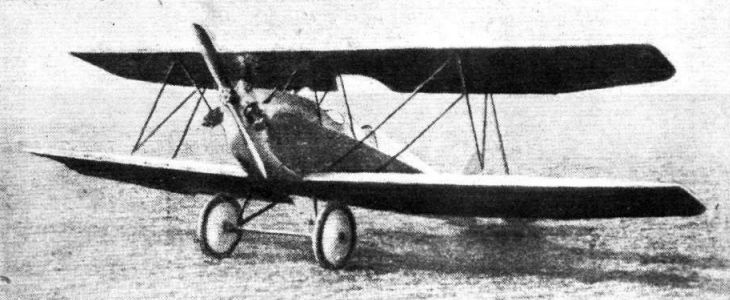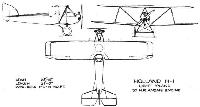
Flight, November 1924
THE "HOLLAND" LIGHT PLANES
SOME of our readers will, no doubt, remember our description - which appeared in FLIGHT for November 29, 1923 - of the Carley Light Monoplane, produced by a Dutch Limited Company, at s'-Gravenhage, the principals of which were Mr. J. D. Carley and Mh. H.v.d. Kwast. Since our last description further developments have taken place, and the company, now known as Vliegtuig-Industrie "Holland," has produced two new types.
<...>
The second machine, the "Holland H-1," is a biplane of more or less distinctive design, and being, perhaps, the more interesting of the two, we propose confining our remarks to a brief description of this machine.
<...>
The biplane constitutes a type which may be classified as being just between the true light 'plane (or "motor gliders," as some still insist on calling them), fitted with a motor-cycle type of engine, and the low-powered small aeroplane. It is, in other words, similar in general construction and design to the light 'plane of today, but instead of being fitted with the usual high-speed low-powered motor-cycle type engine, it has a 35 h.p. 3-cyl. Anzani aviation engine - as we suggested a short while back in "Light 'Plane Notes." It has been designed for use either as a school machine or as an economic touring two-seater "Sport 'plane."
The H-1 is a two-seater tractor biplane, having moderately thick-section wings. The top plane, which is straight (i.e., without dihedral), is of shorter span than the lower plane, which is, however, set at a dihedral angle. Both planes are of equal chord, and are not staggered. Narrow ailerons, 5 ft. 3 ins, in span, are mounted on the lower plane only. The wings are built up on two main box spars of spruce and plywood, and the leading and trailing edges are reinforced with plywood. The top 'plane is in two sections, joined in the centre and attached to a cabane of two inverted V-streamline steel tubes, mounted on the top of the fuselage. The lower plane is also in two section, each being attached directly to the lower longerons of the fuselage. Upper and lower planes are connected on either side of the fuselage by a single pair of N interplane struts of streamline steel tube, and by two sloping struts running from the fuselage, at the lower plane attachments, up to the upper ends of the N struts. The N struts, it will be noticed, are inclined inwards from lower to top planes. The rear portion of the top plane immediately above the fuselage is cut away in order to allow of a clear view upwards from the rear cockpit.
The tail surfaces comprise a comparatively small horizontal stabilising surface, adjustable during flight, to which are hinged unbalanced elevators, and a fixed vertical triangular fin to which is hinged the unbalanced rudder. The horizontal and vertical stabilising surfaces are unbraced, and the latter is built integral with the fuselage. The fuselage is of rectangular section, tapering to a vertical knife-edge at the rear. It is covered with plywood except for the forward portion, from the engine to the pilot's cockpit, which is covered with duralumin. The top of the fuselage is built up to form a deep continuous fairing for the head of the occupant in the rear cockpit. It follows the contour of the head and shoulders more or less from cockpit to tail, and like the covering of this portion of the fuselage is constructed of plywood. The total length of the fuselage is 19 ft. and the maximum width at the pilot's cockpit is 2 ft. 4 ins. Dual control is fitted, each cockpit being provided with the necessary "gadgets." The front cockpit is fairly well forward, while the rear cockpit is immediately beneath the rear portion of the top plane.
The engine is a three-cylinder radial air-cooled Anzani, developing 30-35 h.p., driving direct a 6-ft. diameter tractor screw. Only the heads of the cylinders project through the cowling. The fuel tanks are located within the fuselage, at the rear of the engine, giving a normal range of action of three hours. The petrol tank has a capacity of 8-3 gals., and the oil tank a capacity of 2 gals. - the latter being on the large size in order to allow an extra or larger petrol tank being fitted should it be required to increase the range of the machine.
A conventional V-type landing gear is fitted, consisting of two V's of streamline steel tube carrying, by means of the usual Sandow shock-absorbers, a tubular axle and two wheels, 1 ft. 8 ins. diameter. The wheel track is 4 ft. 3 ins.
The main characteristics of the Holland H.1 biplane are :-
Span (top) 24 ft. 6 ins.
Span (bottom) 25 ft. 6 ins.
Chord 4 ft. 5 ins.
Overall length 21 ft.
Area of main planes 150-6 sq.ft.
Weight, empty 484 lb.
Weight, laden 869 lbs.
Useful load (including fuel) 385 lbs.
Weight per sq. ft. 5-74 lbs.
Weight per horse-power 24-2 lbs.
Speed range 22-71 m.p.h
- Flight, November 1924
THE "HOLLAND" LIGHT PLANES
Фотографии
-
Flight 1924-11 / Flight
The "Holland H.1" biplane: This is a two-seater machine which may be described as a light 'plane "just growing up." It is fitted with a 30-35 h.p. Anzani engine.
-
Flight 1924-11 / Flight
The "Holland H.1" biplane: Three-quarter rear view.
-
Flight 1924-11 / Flight
Holland H-1 Light 'Plane 35 hp Anzani Engine
- Фотографии


